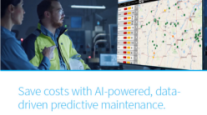Fleets Look to Predictive Analytics

The term “predictive analytics” is becoming increasingly familiar within the trucking industry as fleets look to make better use of the data collected by their back-office and onboard systems.
Years ago, people in the industry talked about predictive analytics “as a crystal ball, some kind of magic that predicts the future — and sometimes it can feel that way, but that’s not what predictive analytics really is,” said Chris Orban, vice president of Trimble Transportation Analytics, which provides analytics and data science capabilities for Trimble companies PeopleNet, TMW Systems and ALK Technologies. “It’s using what we know has happened in the past to give us the likelihood of similar events occurring in the future.”

Nussbaum Transportation, a carrier in Hudson, Ill., uses the SmartDrive system. (TT file photo)
In trucking, the advent of big data is enabling the development and implementation of predictive analytics for a range of applications, especially safe driving and driver retention, said Lauren Domnick, senior director of analytics and modeling for Omnitracs.
“We’re immersed in predictive analytics throughout our day,” she said, pointing to the online shopping experience at Amazon.com, which displays a list of related products that previous buyers have purchased, and Netflix, which makes recommendations based on what its customers have watched.
As part of its driver-retention efforts, PS Logistics of Birmingham, Ala., puts a premium on the connection between driver managers and drivers, giving managers the discretion to send a driver home, for example, or to make other accommodations “to get that driver happy and productive again,” said Kimberley Daigle, vice president of human resources.
Within PS Logistics are carriers including P&S Transportation, a flatbed carrier, and Purdy Brothers Trucking, a refrigerated and dry van carrier. The trucking businesses operate some 2,500 trucks and use Omnitracs Analytics’ driver retention model, Daigle said.
The model is designed to analyze data such as hours-of-service logs and identify subtle changes in driver behavior, which represent a pattern that typically precedes a driver’s decision to quit the company. The system analyzes driver activity, including on-duty not-driving time, shift start variability, early shift starts, days off and HOS violations.
If the results indicate that a driver is 90% to 100% likely to be thinking of leaving, the system sends an e-mail to the driver manager or supervisor that includes the possible reason, such as a family matter “and then it gives you some ideas, some suggestions, on how to start a conversation with them,” Daigle said.
LIVEONWEB: Predictive analytics, blockchain and more
PS Logistics’ practice was to have driver managers make virtually all of these calls to the drivers, but the conversations with drivers who were thought to be on the verge of leaving for family reasons proved daunting.
“We realized that most of our driver managers are fresh out of college,” Daigle said. Discussing family life and children with veteran drivers whose average age is mid-40s was “very awkward” for the recent graduates, she said.
As a result, the company began having supervisors and terminal managers make those critical calls to drivers who were 90% to 100% likely to be thinking of quitting.
In cases where the chances are rated lower, the driver managers continue to make the calls. There’s a bit of risk in doing that, but it allows the company “to give them some experience with these sorts of calls that are so critical to really being a good manager,” Daigle said.
For predictive analytics to work, it must derive patterns from large volumes of data — big data.
Lytx Inc., provider of the DriveCam video-safety program, said it has accumulated data on 80 billion driving miles.
“The next wave of predictive analytics will be leveraging machine learning to capture additional operational risk in and around the vehicle, not just inside the cab,” said Michael Phillippi, Lytx’s vice president of technology. Machine learning is the ability of computers to learn from data without being explicitly programmed to do so.
Beyond its core DriveCam product, the company is capturing additional data with its Lytx Video Services, which combines an event recorder with onboard video cameras connected to the cloud to give fleet managers insight into what is happening with their cargo, the vehicle or at the point of delivery.

Lytx Inc. offers a DriveCam video safety program as well as Lytx Video Services. (Lytx Inc.)
Meanwhile, SmartDrive Systems is nearing 100,000 computer-camera devices in vehicles, said Slaven Sljivar, vice president of analytics for the company. The videos are triggered by, and record, about 70 types of events, including collisions, near-collisions, cellphone use, close following and unsafe lane changes. But the amount of specific event-related video transmitted to users is a fraction of what SmartDrive starts with, Sljivar said. Part of that is cost control — avoiding the expense of sending video and data over a cellular network. Under one SmartDrive plan, a user can receive video on 20 events per vehicle per month, each video averaging 20 seconds, or 400 seconds per vehicle per month.
Sljivar said the descriptor “predictive” analytics is a bit of a misnomer. It does not mean, for example, that a predictive analytics model can tell who will get into a collision, he said. Instead, it analyzes data to identify “what drivers were doing that was different from drivers who didn’t get into a collision.” From there, fleet managers, in a sense forewarned about potential trouble, can formulate constructive coaching approaches, Sljivar said.
That kind of coaching is being done at Nussbaum Transportation, a carrier in Hudson, Ill., that uses the SmartDrive system, said Jeremy Stickling, vice president of human resources and safety. “Since we aren’t dealing with tickets or accidents or near-misses — a bad result — we try to make it a positive, nondisciplinary, noncorrectional, put-it-out-there type of approach," Stickling said.

(SmartDrive Systems)
The carrier created a mobile app to give drivers performance ratings on a 1-to-10 scale. A mix of factors including productivity contribute to those ratings. Coaching sessions with drivers feature questions such as: How do you go into this corner? How do you position yourself in traffic?
“Having these conversations about behaviors and your driving mind-set and your driving approach before the accidents happen has just been way more effective,” Stickling said. “We absolutely see lower crash rates.”
Marketers of predictive analytics systems said they were developing new applications.
Intelligent routing — incorporating weather, traffic, dwell time and miles per gallon — to plan trips with the shortest or the fastest time, is a prime goal in predictive analytics, Omnitracs’ Domnick said. Intelligent routing also poses “one of the most complex problems to explore right now.”
Another Omnitracs project underway focuses on critical events and “critical event video,” Domnick said, citing an icy off-ramp as an example. The posted speed limit might be 45 mph, but in extremely icy conditions drivers might need to be alerted that they should slow to 25 mph. The company could track all of the critical events occurring on the ramp through collected and analyzed data, and warn drivers to exercise extra caution, she said. “It’ll be in near-real time, taking into account the critical events that have happened in the recent past. Maybe the recent past is the last hour.”
Where there is a stretch of roadway with an exceptional number of lane departures, Domnick said, “We could alert a driver that they’re approaching this [stretch] and tell them to make sure they stay in their lane or reduce speed a little bit.”
In March, SmartDrive introduced a new version of its Transportation Intelligence Platform and new hardware, SR4, which the company said was designed to provide more storage capacity for recording, and with options for integrating more data from other onboard systems.
Trimble Transportation Analytics has assembled a predictive maintenance model, Orban said. It’s designed to identify trucks that are more likely to have “what we call ‘red lamp’ faults — the diagnostic trouble codes that are going to actually derate an engine — before they happen,” he said. “This can help a fleet maintenance department target those trucks before they might break down on the side of the road in rural Nebraska somewhere and cause a real serious operational problem.”




